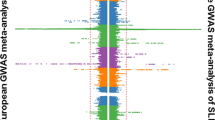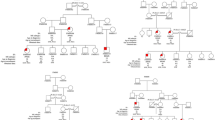Abstract
Leprosy, a chronic infectious disease caused by Mycobacterium leprae, is prevalent in India, where about half of the world's estimated 800,000 cases occur1. A role for the genetics of the host in variable susceptibility to leprosy has been indicated by familial clustering, twin studies, complex segregation analyses and human leukocyte antigen (HLA) association studies. We report here a genetic linkage scan of the genomes of 224 families from South India, containing 245 independent affected sibpairs with leprosy, mainly of the paucibacillary type. In a two-stage genome screen using 396 microsatellite markers, we found significant linkage (maximum lod score (MLS)=4.09, P<2×10−5) on chromosome 10p13 for a series of neighboring microsatellite markers, providing evidence for a major locus for this prevalent infectious disease. Thus, despite the polygenic nature of infectious disease susceptibility, some major, non-HLA–linked loci exist that may be mapped through obtainable numbers of affected sibling pairs.
This is a preview of subscription content, access via your institution
Access options
Subscribe to this journal
Receive 12 print issues and online access
$209.00 per year
only $17.42 per issue
Buy this article
- Purchase on Springer Link
- Instant access to full article PDF
Prices may be subject to local taxes which are calculated during checkout

Similar content being viewed by others
References
WHO Elimination of leprosy as a public health problem. Wkly Epidemiol. Rec. 73, 308–312 (1998).
Aredath, S.P. The occurrence of leprosy in an eight-member family—a case report. Lepr. Rev. 55, 47–50 (1984).
Shields, E.D., Russell, D.A. & Pericak-Vance, M.A. Genetic epidemiology of the susceptibility to leprosy. J. Clin. Invest. 79, 1139–1143 (1987).
Chakravartti, M.R. & Vogel, F. A twin study on leprosy. in Topics in Human Genetics (ed. Becker, P.E.) 1–123 (Georg Thieme, Stuttgart, 1973).
Mohammed Ali, P. & Ramanujam, K. Leprosy in twins. Int. J. Lepr. 34, 405–406 (1966).
Abel, L. & Demenais, F. Detection of major genes for susceptibility to leprosy and its subtypes in a Caribbean island: Desirade island. Am. J. Hum. Genet. 42, 256–266 (1988).
Feitosa, M.F., Borecki, I., Krieger, H., Beiguelman, B. & Rao, D.C. The genetic epidemiology of leprosy in a Brazilian population. Am. J. Hum. Genet. 56, 1179–1185 (1995).
Todd, J.R., West, B.C. & McDonald, J.C. Human leukocyte antigen and leprosy: study in northern Louisiana and review. Rev. Infect. Dis. 12, 63–74 (1990).
Risch, N. Assessing the role of HLA-linked and unlinked determinants of disease. Am. J. Hum. Genet. 40, 1–14 (1987).
Davies, J.L. et al. A genome-wide search for human type 1 diabetes susceptibility genes. Nature 371, 130–136 (1994).
Lander, E.S. & Kruglyak, L. Genetic dissection of complex traits: guidelines for interpreting and reporting linkage results. Nature Genet. 11, 241–247 (1995).
Kruglyak, L. & Lander, E.S. Complete multipoint sib-pair analysis of qualitative and quantitative traits. Am. J. Hum. Genet. 57, 439–454 (1995).
Abel, L. et al. Susceptibility to leprosy is linked to the human NRAMP1 gene. J. Infect. Dis. 177, 133–145 (1998).
Marquet, S. et al. Genetic localization of a locus controlling the intensity of infection by Schistosoma mansoni on chromosome 5q31–q33. Nature Genet. 14, 181–184 (1996).
Marquet, S., Abel, L., Hillaire, D. & Dessein, A. Full results of the genome-wide scan which localises a locus controlling the intensity of infection by Schistosoma mansoni on chromosome 5q31–q33. Eur. J. Hum. Genet. 7, 88–97 (1999).
Rihet, P. et al. Malaria in humans: Plasmodium falciparum blood infection levels are linked to chromosome 5q31–q33. Am. J. Hum. Genet. 63, 498–505 (1998).
Bellamy, R. et al. Genetic susceptibility to tuberculosis in Africans: a genome-wide scan. Proc. Natl. Acad. Sci. USA 97, 8005–8009 (2000).
Haile, R.W., Iselius, L., Fine, P.E. & Morton, N.E. Segregation and linkage analyses of 72 leprosy pedigrees. Hum. Hered. 35, 43–52 (1985).
Ridley, D.S. & Jopling, W.H. Classification of leprosy according to immunity. A five-group system. Int. J. Lepr. Other Mycobact. Dis. 34, 255–273 (1966).
Dib, C. et al. A comprehensive genetic map of the human genome based on 5,264 microsatellites. Nature 380, 152–154 (1996).
Satsangi, J. et al. Two stage genome-wide search in inflammatory bowel disease provides evidence for susceptibility loci on chromosomes 3, 7 and 12. Nature Genet. 14, 199–202 (1996).
Risch, N. Linkage strategies for genetically complex traits. III. The effect of marker polymorphism on analysis of affected relative pairs. Am. J. Hum. Genet. 46, 242–253 (1990).
Risch, N. Linkage strategies for genetically complex traits. II. The power of affected relative pairs. Am. J. Hum. Genet. 46, 229–241 (1990).
Holmans, P. Asymptotic properties of affected-sib-pair linkage analysis. Am. J. Hum. Genet. 52, 362–374 (1993).
Acknowledgements
We thank the authorities and staff of the Hindu Mission Hospital and the Sacred Heart Leprosy Centre, Kumbakonam, Sakthi sugar factory voluntary health services, Erode, Madurai Kamaraj University, Madurai, and the JALMA Institute, Agra, for assistance, permissions and facilities and support; the families for their cooperation and consent; J.H. Edwards for facilitation; and the field teams for assistance. S.M. is an MRC clinical research fellow. A.V.S.H. is a Wellcome Trust Principal Research Fellow.
Author information
Authors and Affiliations
Corresponding author
Supplementary information
Rights and permissions
About this article
Cite this article
Siddiqui, M., Meisner, S., Tosh, K. et al. A major susceptibility locus for leprosy in India maps to chromosome 10p13. Nat Genet 27, 439–441 (2001). https://doi.org/10.1038/86958
Received:
Accepted:
Issue Date:
DOI: https://doi.org/10.1038/86958
This article is cited by
-
Human genetics of mycobacterial disease
Mammalian Genome (2018)
-
A Call to Action for Mycetoma
Current Fungal Infection Reports (2018)
-
Genetische Untersuchungen an Kindern mit schweren bakteriellen Infektionserkrankungen
Monatsschrift Kinderheilkunde (2015)
-
CUBN and NEBL common variants in the chromosome 10p13 linkage region are associated with multibacillary leprosy in Vietnam
Human Genetics (2014)
-
NOD2 and CCDC122-LACC1 genes are associated with leprosy susceptibility in Brazilians
Human Genetics (2014)



